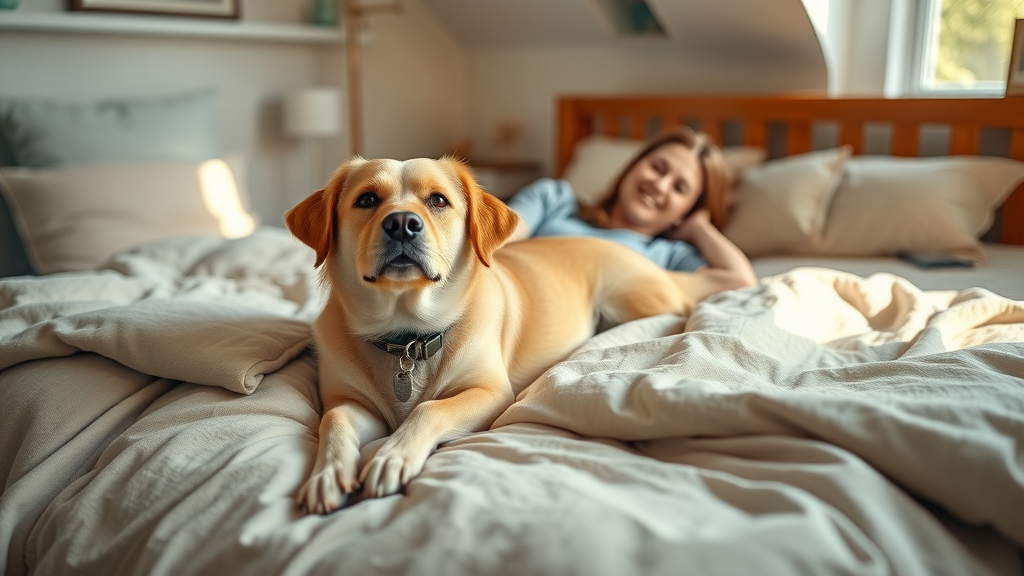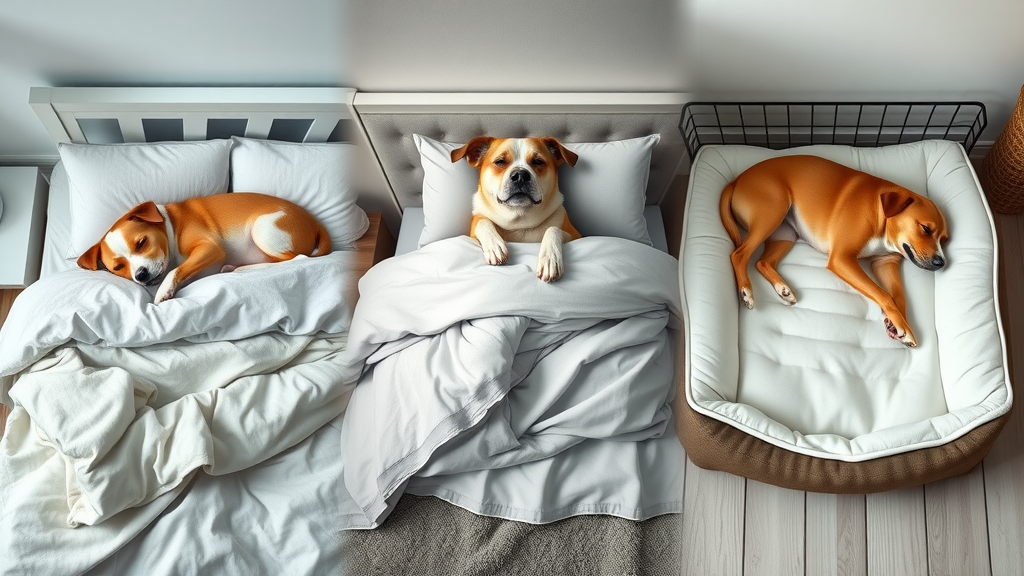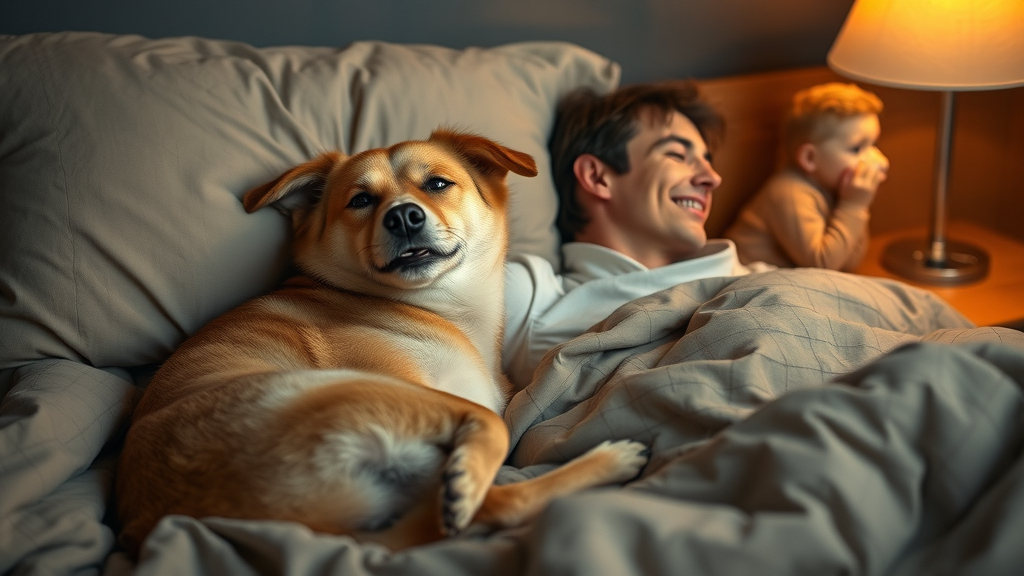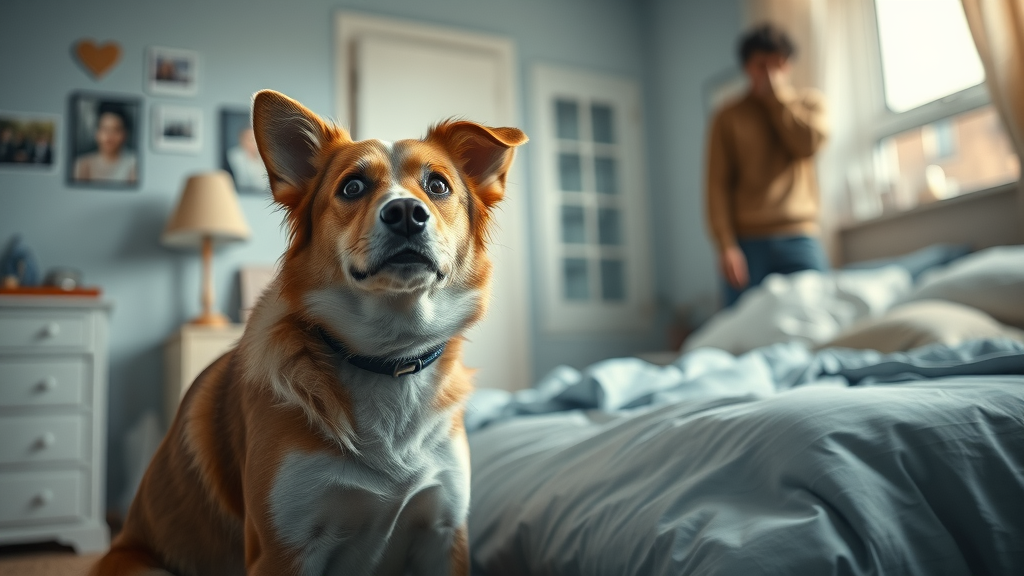Have you ever wondered if sharing your bed with your furry friend is a good idea—or could it secretly be harming your sleep, their behavior, or even your health? The answer might surprise you and even challenge what you think you know about dog sleep habits!
Should I Let My Dog Sleep in Bed With Me? Exploring How Our Pets Shape Our Nights
The question “should I let my dog sleep in bed with me?” is as old as dog ownership itself. For many dog owners, sharing a bed at night with their loyal companion feels like the ultimate comfort, a testament to the deep bond humans have with their pets. Yet, others worry about disrupted sleep, allergies, or encouraging bad dog behavior. If you’re weighing whether to let your dog sleep on your bed, you’re not alone. Countless pet parents face this nightly decision, and there’s no one-size-fits-all answer.
Some pet parents say their dog sleeping beside them eases separation anxiety for both dog and owner. Others admit that a restless sleeper—whether human or canine—can make a good night’s rest difficult to come by. Practical factors, including the size, breed, and temperament of your dog, plus your own preferences and health, all influence whether sharing a bed is the right choice. In the sections below, we’ll look at the science, expert opinions, and real-life stories of dog owners who have made this choice, and what they’ve learned along the way.

"Is sleeping with your dog a cozy comfort, or could it be disrupting your rest and theirs? Experts weigh in—and pet parents everywhere are weighing their options."
Understanding the Debate: Pros and Cons of Letting Your Dog Sleep in Bed
Letting your dog share your bed can transform your nightly routine—but not always for the better. While many enjoy increased comfort and deeper companionship, others notice drawbacks. So, what are the real advantages and disadvantages? Below, you’ll find key points reported by veterinarians, dog trainers, and countless pet owners.
Research and anecdotal evidence highlight that sleeping with your dog can both strengthen the human-animal bond and introduce counterproductive routines. For the social dog or anxious pet parent, co-sleeping can be a source of mutual comfort and warmth, often helping to beat separation anxiety and stress. On the flip side, dogs sleep differently than humans, and their movement, scratching, or even barking at night can disrupt your sleep pattern. Hygiene is also a serious concern—allowing your dog in your bed can introduce allergens, dirt and, in rare cases, parasites, especially if preventive health care lapses.
-
Benefits of dog sleep in your bed:
- Strengthens the human-animal bond
- Can help reduce separation anxiety (in both dog and owner)
- Offers warmth and emotional comfort
-
Drawbacks of sleeping with your dog:
- Possible sleep disruptions for both you and your dog
- Allergen transfer and hygiene issues
- Potential behavior challenges, such as possessiveness or separation anxiety
| Option | Best for | Main Drawbacks |
|---|---|---|
| Human Bed | Bonding, anxious dogs | Sleep interruption, hygiene |
| Dog Crate | Training, structure | Less intimacy |
| Dog Bed on Floor | Independence | Less shared warmth |

The Science Behind Dog Sleeping in Your Bed: What Research and Experts Say
Understanding why dogs sleep with their owners—and whether it’s a good idea—starts with science. Numerous studies, including those from the Mayo Clinic, have linked sleeping with your pet to varying outcomes. Some research finds that the presence of a dog in bed can actually enhance feelings of safety and relaxation for pet owners, which may lower blood pressure and reduce nighttime stress. In some cases, owners report falling asleep faster with their dog to sleep beside them.
However, experts also note that dogs sleeping in your bed can increase the odds of sleep fragmentation, especially if the dog moves frequently, snores, or dreams actively. This is particularly true if your pet is young, untrained, or prone to restless activity at night. Many veterinarians and behaviorists recommend individualized solutions—not every dog or person is suited for co-sleeping. Monitoring your own sleep quality is recommended before making any major changes in where your dog sleeps.
"A recent Mayo Clinic study found that while some people report disrupted sleep patterns with dogs in the bed, others sleep more soundly—largely thanks to their pet’s presence."
Dog Sleep Hygiene: Does Allowing Your Dog to Sleep in Bed Affect Health?
Of course, sleeping with your dog raises important questions about health and hygiene—for you and your pup. Dogs can carry dander, fur, dust, and sometimes parasites, all of which might affect your sleep quality or trigger allergies, particularly in sensitive individuals. Regular vet checkups, grooming, and using washable bedding are a must if you decide to let your dog sleep in bed. Prioritizing dog hygiene helps prevent the transfer of bacteria or pests, keeping both you and your furry friend healthy during those nights of close contact.
While most healthy dogs and humans experience few issues co-sleeping, experts caution that immunocompromised or allergic pet owners may want to explore alternatives, like a dog bed on the floor or crate in the bedroom. In either case, communication with your vet can help determine if sleeping in your bed is the safest option for everyone involved.
Is It Healthy for Dogs to Sleep With Owners? (People Also Ask)
Research suggests that allowing your dog to sleep with you can benefit the dog’s sense of security and well-being. For many dogs, sharing a bed offers warmth, safety, and comfort, which can reduce anxiety and create a calm sleep environment. However, dogs that become overly attached or resource guard the bed may exhibit mild behavior changes or separation anxiety. If your dog is healthy, well-groomed, and respects sleep boundaries, sharing a bed can be healthy and rewarding for both of you.
Is It Healthy for Dogs to Sleep With Humans? (People Also Ask)
Just as humans seek comfort and closeness, most domestic dogs enjoy the reassurance that comes from sleeping next to their favorite humans. Co-sleeping may enhance the bond between pet parents and their dogs, promoting trust and affection. Still, experts stress the importance of regular healthcare, monitoring for pest transmission, and creating healthy routines to maximize these benefits while minimizing risks associated with sleeping in your bed with your canine companion.

Is It Safe for Dogs to Sleep With You? (People Also Ask)
For most families, sleeping with your dog is safe as long as your pet is healthy, up to date on vaccinations, and free from parasites. Practice good hygiene by regularly bathing your pup and changing bedding often. Consider your own health, and that of your household members, especially if anyone is immune-compromised or has notable allergies. Setting clear boundaries on where your dog sleeps (such as the foot of the bed) can help prevent any issues with resource guarding and keep the arrangement stress-free.
When Should I Let My Dog Sleep With Me? (People Also Ask)
If you’re considering letting your dog sleep on the bed, trainers recommend waiting until your pet is fully house-trained and can sleep through the night without accidents. Puppies and newly adopted dogs may benefit from initially using a crate or dog bed on the floor to foster routine and independence. Once your dog demonstrates stable behavior, respects boundaries, and you’re comfortable with the hygiene commitment, that’s a good time to try letting your dog join you in bed.
Dog to Sleep in Bed: Benefits for Dog Owners and Their Pets
The benefits of sleeping with your dog go beyond simple companionship. Studies show that pet owners who allow their dog to sleep in their bed often experience deeper feelings of security and contentment. The rhythmic breathing and natural warmth from your dog can soothe nerves and reduce stress, especially after a difficult day. Bonding at bedtime can send a powerful message of love and trust to both owner and dog—and sharing a bed with your dog has even been linked to lower rates of nighttime anxiety for some pet parents.
- Increased feelings of security and comfort
- Reduced anxiety and stress after a challenging day
- Mutual warmth during cold nights
- Strengthened owner-dog connection
For many, the emotional benefits of sleeping with your dog outweigh the downsides. Cuddling with your dog to sleep can make bedtime a highlight for both pet parent and pup, fostering a sense of family that can carry over into daytime routines and overall well-being. That said, it’s important to weigh the pros and cons for your specific household.

Potential Downsides: Understanding the Risks of Allowing Your Dog to Sleep in Bed
Every arrangement has its risks, and letting your dog share your bed is no exception. The most common complaints include disrupted sleep, allergic reactions, and potential transmission of fleas, ticks, or other parasites. Dogs sleep patterns differ from ours, so even small movements, scratching, or sudden noises during the night can make you a restless sleeper. Owners with sensitive immune systems or allergies must also be cautious—dog dander, fur, and saliva left on bedding can spike allergic symptoms.
- Disrupted sleep from dog movements or barking at night
- Allergic reactions triggered by dander or fur, especially for sensitive individuals
- Heightened risk for parasite transmission without proper preventive care
- Behavior challenges, including separation anxiety or resource guarding
Another pitfall of letting your dog sleep on your bed is the potential for behavioral issues. Some dogs may begin to guard their sleeping spot, displaying resource guard tendencies or separation anxiety when left alone. Establishing boundaries or routines early can help prevent such problems, especially for dogs that are prone to dependency or territorial behavior in the bedroom.

Separation Anxiety and Behavioral Impacts: What Dog Trainers and Experts Report
Many dog trainers and canine behaviorists agree: while sleeping with your dog can reinforce your bond, it comes with potential behavioral impacts. Dogs that are always allowed to sleep with you may develop dependency, making it harder for them to cope with alone time. This can manifest as whimpering, destructive chewing, or other signs of separation anxiety when you leave for work or travel.
The key is moderation and establishing healthy boundaries. As dogs sleep more lightly than people, they often wake up if you move, which can increase both parties’ night-time alertness. If your dog shows signs of distress when they can’t share your bed, it might be time to reconsider the sleeping arrangement, or work with a certified dog trainer to build confidence and independence.
"Allowing your dog to sleep in bed can strengthen your bond, but for dogs with separation anxiety, it may reinforce dependency rather than independence." — Certified Dog Trainer
Proactive steps, like providing a comforting dog bed nearby, crate training, and reinforcing independent behaviors during the day, can help mitigate emerging problems before they become difficult habits to break.

Expert Opinions: Leading Veterinarians and Dog Trainers on Sleeping With Your Dog
Veterinarians generally say that allowing your dog in your bed is a personal choice, as long as everyone in the household is healthy and happy. Dogs that sleep with their owner may benefit from a comforting routine, but vets recommend regular flea and tick prevention, as well as scheduled wellness visits. Addressing behavior and hygiene concerns up front can make sleeping together a safe, enjoyable experience for all involved.
- Veterinarian viewpoints: Healthy pets and clean routines make co-sleeping low-risk for most households.
- Dog trainer insights: Set boundaries and use positive reinforcement to manage where your dog is allowed to sleep. Not all dogs are suited for sleeping in bed; some benefit more from their own sleeping spot.
- Behaviorist advice: Consistency is key. Dogs with a tendency for separation anxiety may need gradual independence, with routines that ease anxiety and encourage self-confidence.
Weighing the Evidence: Should I Let My Dog Sleep in Bed With Me?
So, should you let your dog sleep in your bed? The final decision depends on your household’s health, your own preferences, and your dog’s behavior and temperament. Use the following steps to help make an informed, practical decision that benefits everyone:
- Assess your own sleep quality with your dog in bed
- Consider your and your dog's health—including allergies or chronic illnesses
- Observe your pet’s behavior for signs of separation anxiety or aggression
- Weigh the emotional benefits against the potential risks
If your sleep is consistently disrupted, or your dog shows difficult behaviors related to sharing the bed, consider alternative sleep arrangements. Conversely, if co-sleeping improves your quality of life and your dog’s, it may very well be the right choice.

Tips for a Better Night’s Sleep With Your Dog in Your Bed
If you decide that letting your dog sleep on your bed is right for you, a few simple changes can make all the difference. Start by setting a calming bedtime routine—routine helps dogs (and people) wind down. Make sure your dog is clean and pest-free, and select bedding that’s easy to wash and allergen resistant. Teach your pet where they’re allowed to sleep to prevent resource guarding, and only invite them onto the bed when it’s appropriate.
- Establish a bedtime routine for your dog
- Make sure your dog is clean and free of pests
- Use a washable mattress protector
- Train your dog to respect boundaries on the bed
- Select bedding materials that minimize allergens
Ensuring your own and your dog’s comfort can boost sleep quality and help prevent any unintended consequences from sharing your sleeping spot.
Setting Healthy Boundaries: Alternatives to Letting Your Dog Sleep in Your Bed
It’s perfectly okay if sleeping side-by-side with your dog isn’t for you! Many dog owners choose to create special sleeping spots that offer both security and a sense of independence. A dedicated dog bed in your room or a crate nearby can give your pup comfort without sacrificing your own rest. Developing and sticking to a plan that fits your lifestyle and your dog’s needs ensures everyone gets a good night’s sleep.
- Dedicated dog bed in your bedroom
- Crate training for dogs with anxiety or behavioral needs
- Encouraging your dog to sleep on the floor, but close by
- Gradually transitioning your dog out of your bed if needed
Consistency and patience are crucial as you shift routines—always use positive reinforcement and patience to help your pet adjust to a new sleeping arrangement.
Sharing a Bed: Real Dog Owners Share Their Stories
"I wake up every morning to tail wags and puppy kisses—I wouldn't trade it for the world. But I do have to vacuum more often!" — Dog Owner
Dog owners who share their bed with their pets express a wide range of opinions. Some find that letting their dog sleep in bed is the best part of pet ownership, bringing joy, laughter, and a feeling of connectedness each day. Others appreciate the extra work it brings—more frequent cleaning, training, and occasional negotiations with partners over bed space.
At the end of the day, most pet parents agree that all the trade-offs and midnight snuggles shape a relationship that goes beyond standard pet care. Whether you welcome your pet onto your bed or set healthy boundaries, sharing the night and the day with a beloved companion is what makes dog ownership special.

Frequently Asked Questions About Should I Let My Dog Sleep in Bed With Me?
-
Is it bad for separation anxiety to let my dog sleep in bed?
Sometimes, yes. While sleeping in your bed can reduce anxiety for the dog in the short term, it may worsen dependency or make it hard for your dog to cope with alone time. Practice balancing closeness and independence for a well-adjusted pet. -
How do I transition my dog out of my bed?
Start slowly. Move their dog bed near yours, and reward them for staying in their spot. Gradually increase the distance and use positive reinforcement for independent sleeping behaviors. -
Can puppies safely sleep in my bed?
It’s best to wait until your puppy is house-trained and can sleep through the night without accidents. Introducing crate training or a dog bed nearby helps promote good habits. -
What if my partner is allergic to dogs?
If your partner or anyone in the household is sensitive to fur or dander, keeping your dog off the bed—or out of the bedroom—may be best. Frequent washing and grooming can help, but won’t eliminate all allergens. -
Does breed or size matter for dog sleep in your bed?
Yes! Small breeds may be less disruptive, but any breed can develop behavioral issues or disrupt sleep. Consider your personal preferences, health needs, and your dog’s unique temperament before inviting them up for the night.
Best Practices for Dog Sleep: Expert Tips for Safe and Healthy Co-Sleeping
- Schedule regular check-ups with your vet to ensure your dog’s health
- Keep up with flea, tick, and parasite prevention
- Be proactive about washing your hands and bedding
- Train your dog to get on and off the bed only when invited
Sticking to these best practices helps maximize the benefits of sharing your sleeping spot with your dog while minimizing health or behavior risks.
Reflections: Balancing Love and Logic When Deciding Where Your Dog Should Sleep
Key Insights From Dog Sleep Studies and Expert Advice
Dog sleep patterns vary, and their impact on their human companions can be positive or negative depending on routine, health, and behavior. Clinical research and dog trainers alike emphasize that every dog and pet owner is different—what works for one pair may not work for another. If you notice negative impacts on your sleep or dog’s behavior, consider different sleeping arrangements for your dog to sleep at night.
Experts agree that balancing love, common sense, and boundaries creates the healthiest arrangement. Remember, sleeping with your dog should benefit both of you—emotionally, physically, and behaviorally.
Making the Best Choice for Your Family and Your Dog
Ultimately, where your dog sleeps is a personal decision that should prioritize the well-being of your family and your pet. With thoughtful routines, positive reinforcement, and open communication with professionals, you can create a sleeping arrangement that works for everyone under your roof. Take time to observe your needs, your dog’s needs, and adapt as you go—there’s no “wrong” answer when it comes to showing your love and care for your furry best friend.
Subscribe for More Insights on Dog Sleep and Pet Wellness!
🐾 Love pets as much as we do? Get the best tips, treats, and tail-wagging stories delivered monthly. 👉 Subscribe to our newsletter and never miss a bark or purr!
📧 One email. All the value. Join thousands of pet parents who get our monthly roundup of pet care tips, product reviews, and giveaways.
Conclusion: Assess your routines, set boundaries, and talk to experts to ensure the best sleep—for both you and your dog. Your comfort, and your dog’s comfort, matter most!
Allowing your dog to sleep in your bed is a personal decision that comes with both benefits and drawbacks. The American Kennel Club’s article, “Should I Let My Dog Sleep With Me?” , discusses how co-sleeping can strengthen the human-animal bond and provide comfort, but also notes potential issues like sleep disturbances and hygiene concerns. Similarly, the VCA Animal Hospitals’ piece, “Should My Dog Sleep in My Bed?” , highlights that while sharing a bed can enhance feelings of security and companionship, it may also lead to disrupted sleep and exacerbate allergies. If you’re considering this arrangement, these resources offer valuable insights to help you make an informed decision.
 Add Row
Add Row  Add
Add 




Write A Comment